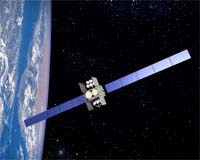 |
Washington DC (SPX) May 26, 2010 The Television Infrared Observation Satellite, known as TIROS-1, was the world's first weather satellite. Fifty years ago in 1960 it lifted off from Cape Canaveral, Fla., opening a new and exciting dimension in weather forecasting. Now, a television producer at NASA's Goddard Space Flight Center in Greenbelt, Md. has created a video to capture this historic satellite's life. NASA-Television producer Vicky Weeks created a video about TIROS-1 that made its debut at event at the National Capitol on May 20, 2010. The event, called "The Climate Connection - In honor of the 50th Anniversary of TIROS" was hosted by the American Institute for Aeronautics and Astronautics (AIAA). "The video includes a progression of imagery, from the first images of TIROS-1 to today's modern-day high-resolution imagery of the Geostationary Operational Environmental (GOES) satellites," Weeks said. "It's amazing to think that only 50 years ago we were looking at weather from above for the first time, and now it's a part of our everyday lives with amazing clarity and resolution." The video begins with sobering imagery of the 1900 hurricane that devastated Galveston, Texas, and claimed over 8,000 lives. Then it takes the viewer on a brief history of weather observation that leads to the birth of the National Weather Bureau in 1870, and the Electronic Numerical Integrator and Computer's first computerized forecast in 1950. Viewers will then see that TIROS-1 burst onto the scene in 1960, as a small hatbox-shaped experimental weather satellite known as a "spinner." The first weather satellite spurred dozens of spacecraft used for weather observations, and a montage of imagery shows the progress made in coverage and resolution. Viewers are left with the realization that the even bigger picture - that of space-based, global climate research as a whole - was born out of the success of TIROS-1. TIROS-1 was a polar-orbiting satellite that weighed 270 pounds and carried two cameras and two video recorders. The satellite's first television picture appeared fuzzy on-screen, and showed thick bands and clusters of clouds over the U.S. A few days after that initial image, TIROS-1 captured a typhoon approximately 1,000 miles east of Australia. NASA and the National Oceanic and Atmospheric Administration, or NOAA, cited the launch of TIROS-1 as an example of a strong agency partnership and commitment to flying the best Earth observation satellites today and in the future. TIROS-1 was NASA's first attempt in using satellites to help scientists study weather systems on Earth. NASA managed the program with help from the U.S. Army Signal Research and Development Lab, RCA, the U.S. Weather Bureau (now the National Weather Service) and the U.S. Naval Photographic Interpretation Center. NASA launched all 10 of the TIROS satellites. Throughout the 1960s, each satellite carried increasingly advanced instruments and technology. By 1965, meteorologists combined 450 TIROS images into the first global view of the world's weather, picking up a line of clouds over the Pacific Ocean barreling toward the United States.
Share This Article With Planet Earth
Related Links For the YouTube version of the video TIROS program Space Technology News - Applications and Research
 Northrop Grumman Tests First Airborne Ka-Band Satellite Terminal
Northrop Grumman Tests First Airborne Ka-Band Satellite TerminalSan Diego CA (SPX) May 26, 2010 Northrop Grumman has successfully completed flight testing of an airborne satellite communications system, part of a network that will significantly enhance communications capabilities for warfighters. This represents the first airborne terminal system to be certified for connection to the Wideband Global Satellite (WGS). The flight test used the communications terminal system installed on ... read more |
|
| The content herein, unless otherwise known to be public domain, are Copyright 1995-2010 - SpaceDaily. AFP and UPI Wire Stories are copyright Agence France-Presse and United Press International. ESA Portal Reports are copyright European Space Agency. All NASA sourced material is public domain. Additional copyrights may apply in whole or part to other bona fide parties. Advertising does not imply endorsement,agreement or approval of any opinions, statements or information provided by SpaceDaily on any Web page published or hosted by SpaceDaily. Privacy Statement |